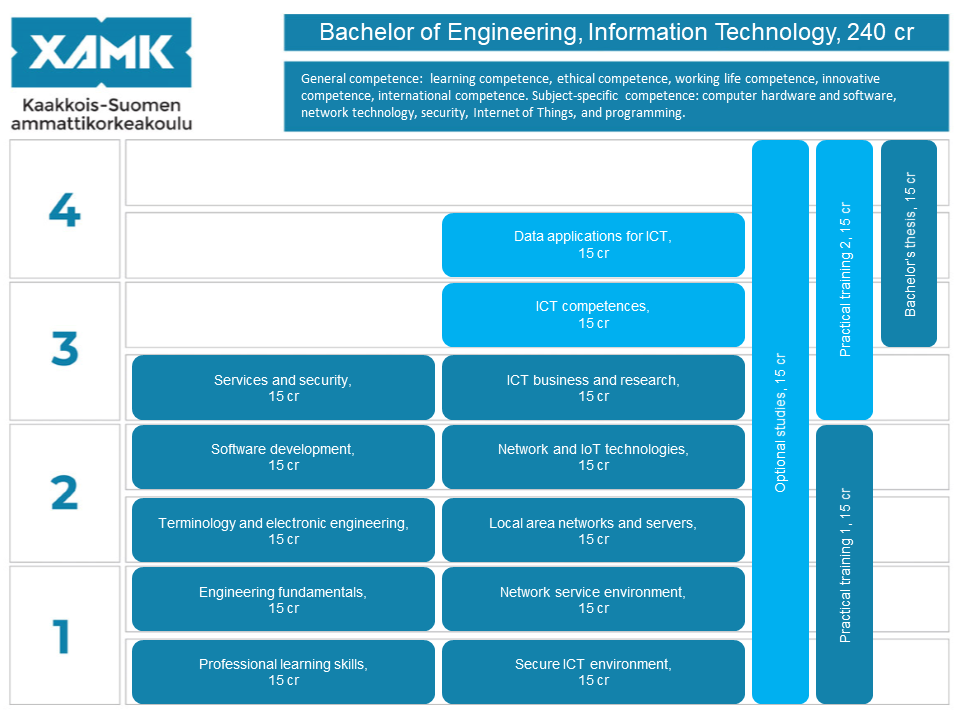Degree Programme in Information Technology
- Degree
- Bachelor of Engineering
- Degree title
- Insinööri (AMK), Bachelor of Engineering
- Credits
- 240 ects
Objectives
Xamk’s Degree Programme in Information Technology program gives you a solid foundation on IT and allows you to specialize in the field of your own interest with a flexible study plan. With this method, you can find and utilize your personal strengths as a future IT engineer.
The program is built around three key themes: networking, data centers and IoT (Internet of Things) which are supported with other topics such as information security, programming and project studies.
In our IT programme you focus on computer networking and the implementation of services in a modern data center environment. You learn to build secure Internet-connected wired or wireless local area networks. You are able to manage and run server environments and understand how data centers operate. Information and network security is also an important part of the studies. Different IT skills are combined together in IoT systems and with which you learn how to develop and prototype services and understand their possibilities in global business.
You also learn programming, which allows you to develop and customize services for your needs. A personal study plan allows you to customize your studies based on your own interests and skills. The studies are carried out in our modern and comfortable campus, with state-of-the-art IT equipment.
Degree programme description
Your competences grow in steps while progressing in your studies. The studies are grouped into modules of usually three courses, and 15 ECTS credits, but there are also annual themes for each study year.
During the first year you are an active learner finding your best learning techniques and working life skills. You gain practical skills in technical issues and learn basic programming. Courses in computer hardware, operating systems, networking and information security give a background to further develop technical knowledge.
During the second year you enhance your knowledge of networking and gain practical skills to design, install, configure and manage secure computer networks. You also become familiar with modern server and data center environments as well as start studying IoT systems. In addition, you develop your programming skills and gain important background knowledge of computer electronics and mathematics courses.
During the third year you collect your skills and know-how together by implementing services and prototypes with IoT devices and servers. You also practice project management skills and have a chance to participate in various projects. When you have gathered all the essential IT skills for your studies, you can select optional advanced topics according to your own interests.
The fourth year is the time to complete your bachelor's thesis. It is wise to start this project of 15 ECTS credits early, and it typically relates to working life. The practical training included in the studies can also be carried out at this time, or earlier, for example, during the summer breaks.
We organize a large part of the studies through Microsoft and Cisco academies, which allows our students to complete Microsoft and Cisco certifications. This is a valuable advantage when searching for a job in the IT market.
Choosing a main subject or field of specialization
We do not offer ready-made specialization options to choose from. Instead, we make a personal study plan for every student, which allows everyone to specialize in the topics of their own interest and based on their skills.
We have a tutor teacher to help making choices related to your studies, practical training, final thesis and a study period abroad.

Implementation of studies
Information Technology -koulutusohjelma toteutetaan päiväopintoina Xamkin Mikkelin kampuksella. Koulutuksen käytössä ovat ajantasaiset oppimisympäristöt ja laitteet.
Career opportunities
The Degree Programme in Information Technology gives you broad IT skills and allows specializing in an area based on your own strengths. This helps you to find your first job.
The role of IT is constantly increasing in our daily life. There is a strong demand for new types of smart systems to support daily routines and wellbeing. Especially the IoT environment is gaining popularity and is expected to change the current business.
Information technology is needed in all areas of business and this opens huge opportunities for an IT professional. Many of our students have found a job related to programming. Other common job options include, for example, working as server and data center managers, implementing services, working with modern cloud environments, designing and managing computer networks, building IoT environments and implementing services with them, or working in IT consulting.
Professional IT positions are, for example, the following:
• data architect
• database administrator
• data center specialist
• information system designer
• IoT designer
• IT consultant
• IT engineer
• network specialist
• project manager
• server administrator
• software developer
• software engineer
• technical specialist
RDI and cooperation with world of work
The Degree Programme of Information Technology is designed to offer a good set of skills to successfully join working life. After some progress in studies you can take part in Xamk’s research projects and in other projects of working life. At its best, your bachelor’s thesis relates to one of the projects commissioned by some company.
Learning environments
Studies in the Degree Programme of Information Technology are arranged in a modern state-of-the-art learning environment where we cooperate with big IT companies, such as Microsoft and Cisco, and their academies. This allows students to complete internationally recognized contents and certifications.
Our Cisco networking lab allows building versatile networking scenarios and get hands-on experience in working with real devices. We also utilize virtual environments to enable running larger and more complex environments. Our teaching environment also includes a modern data center environment where students get to practice data center configuration and management tasks.
Information technology, full-time studies
Timing plan:
Information technology, full-time studies
Timing plan:
Information technology, full-time studies
Timing plan:
Information technology, full-time studies
Timing plan:
Information technology, full-time studies
Timing plan:
